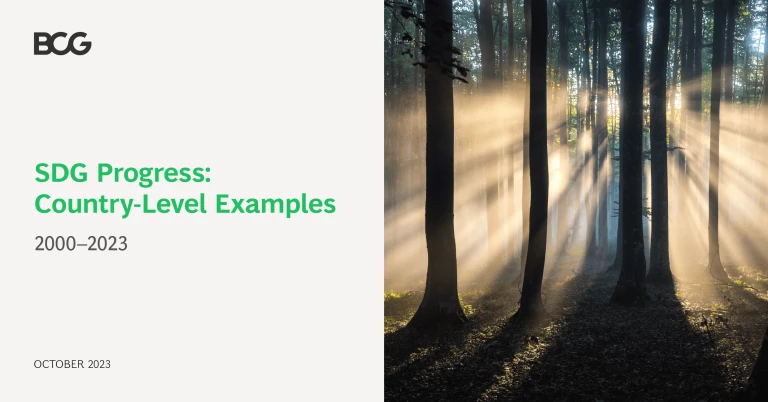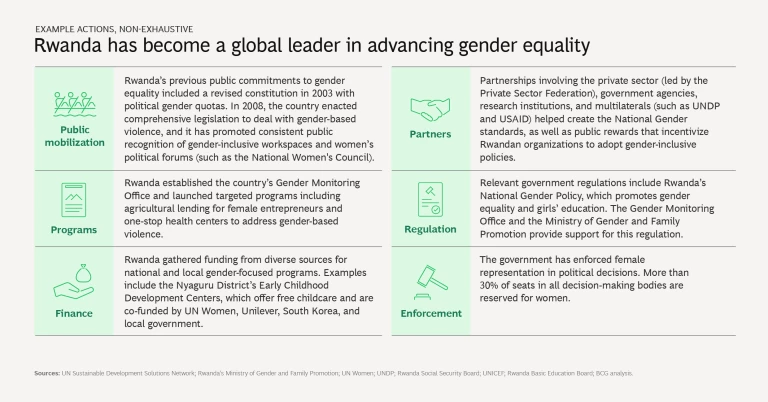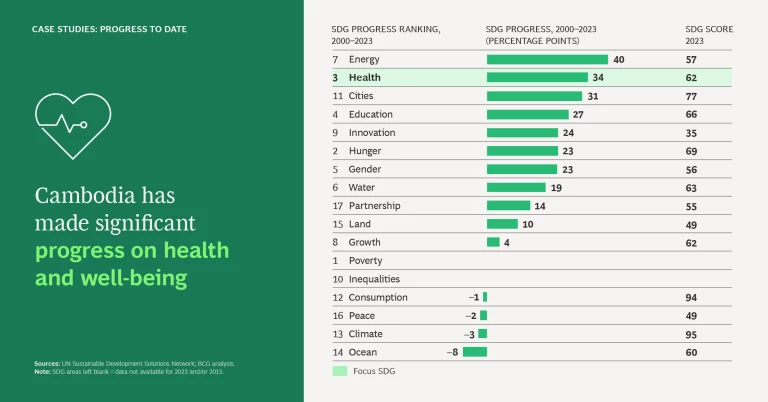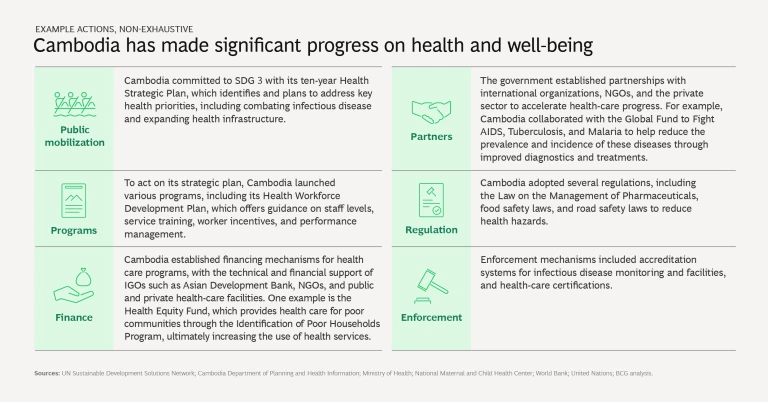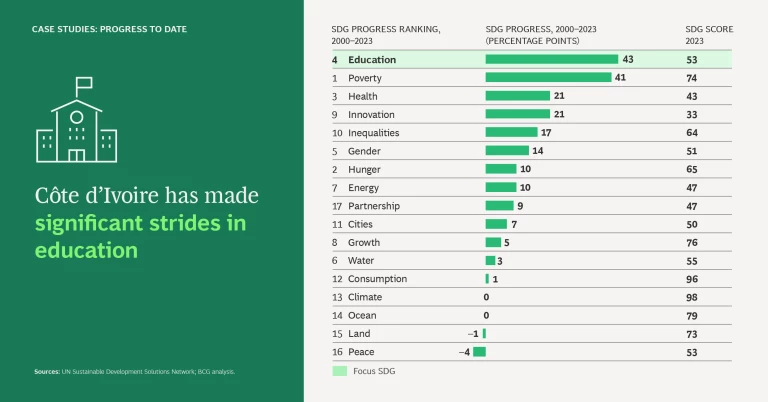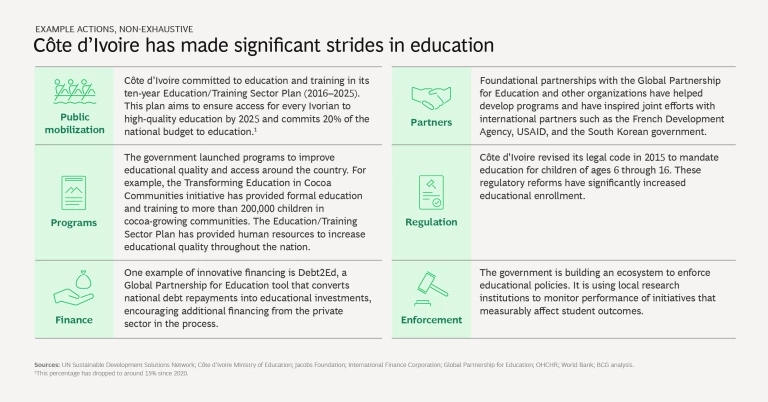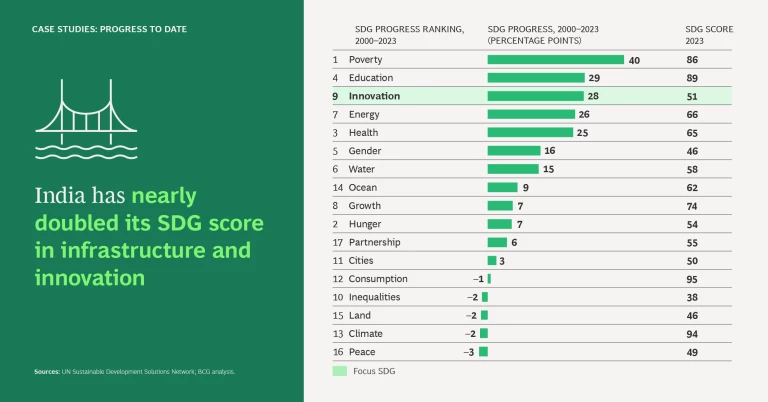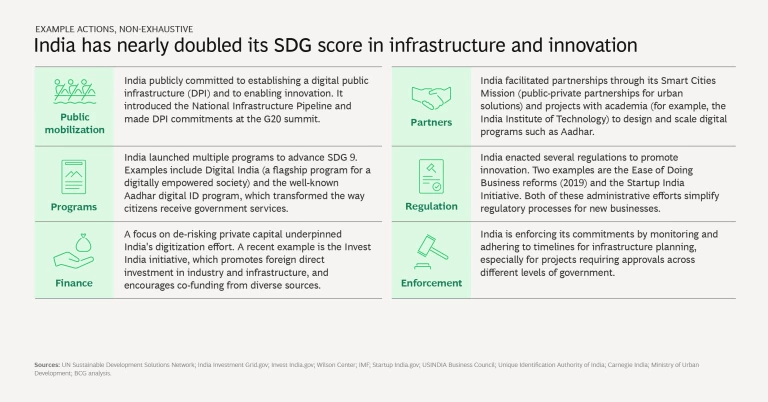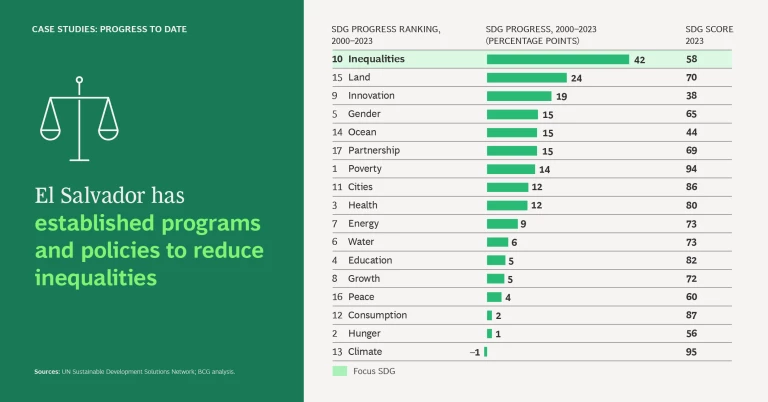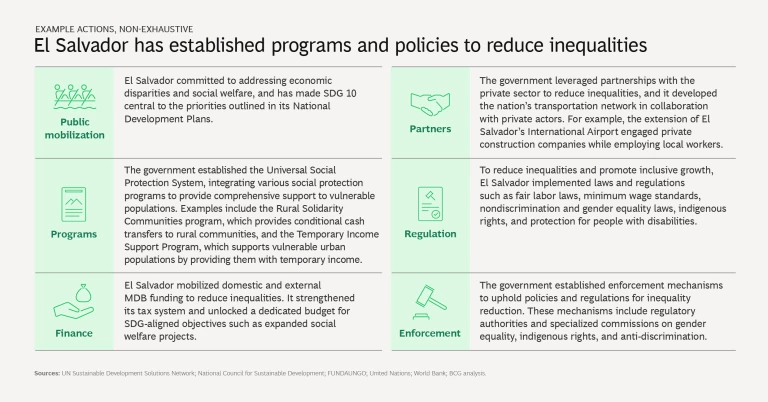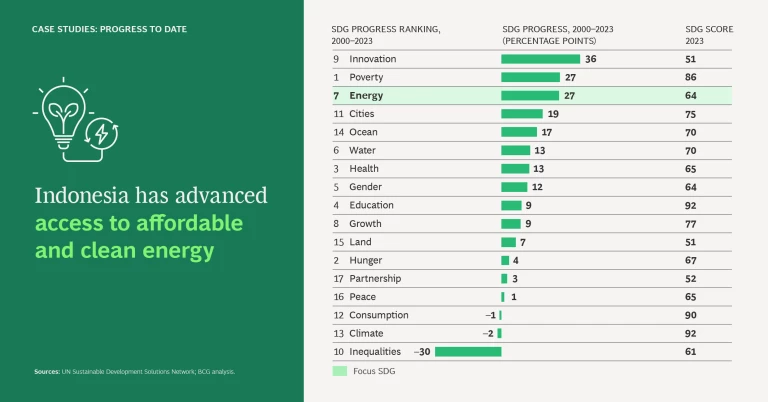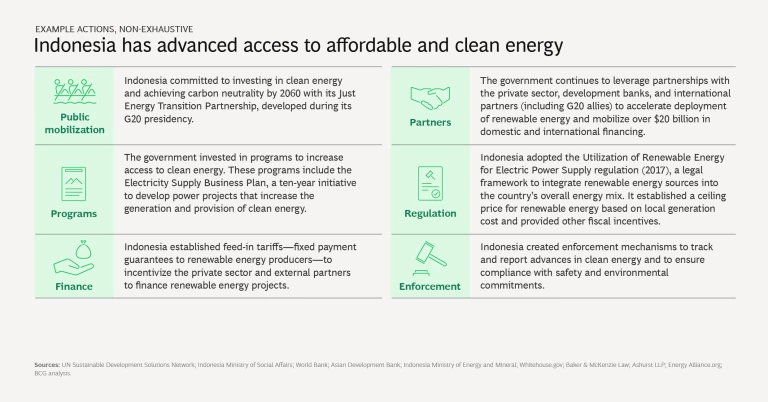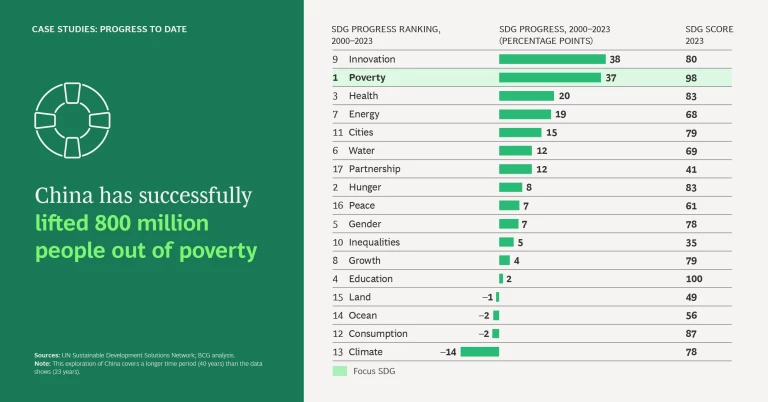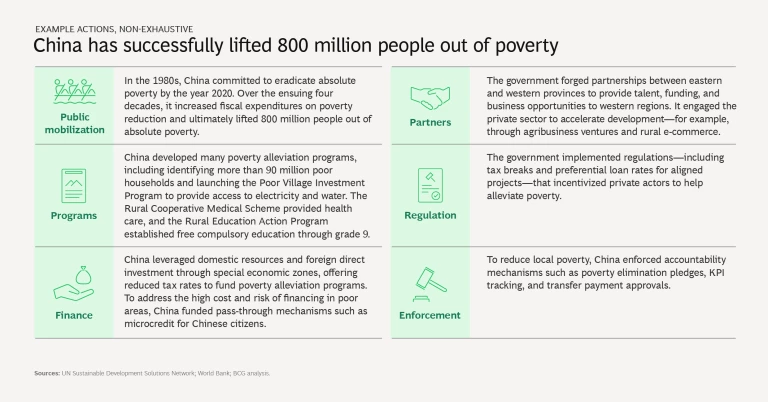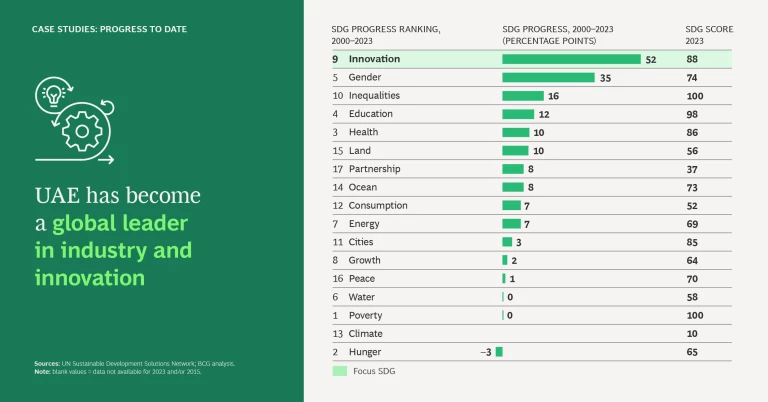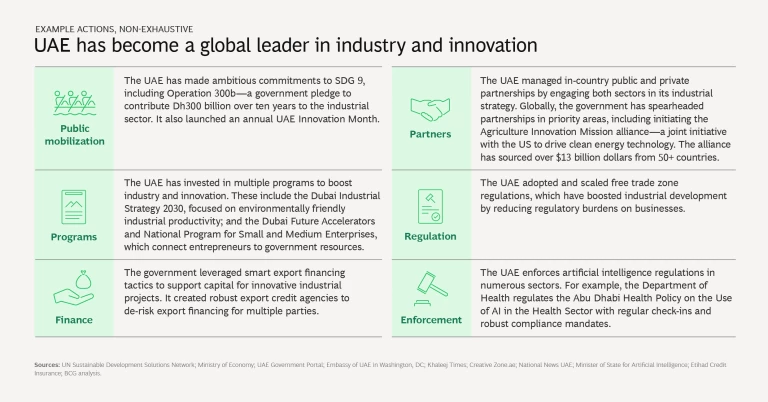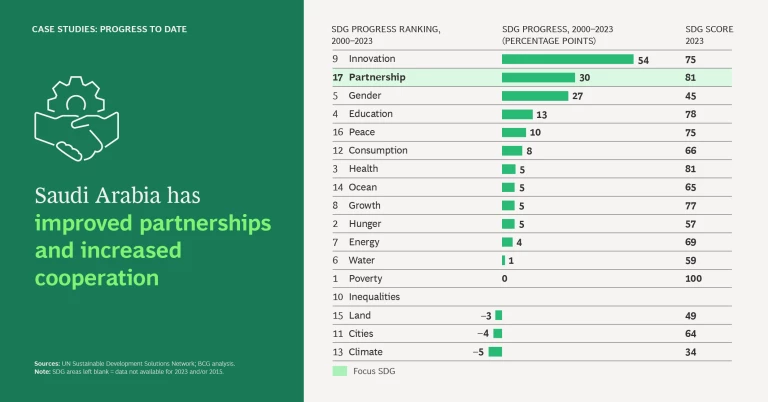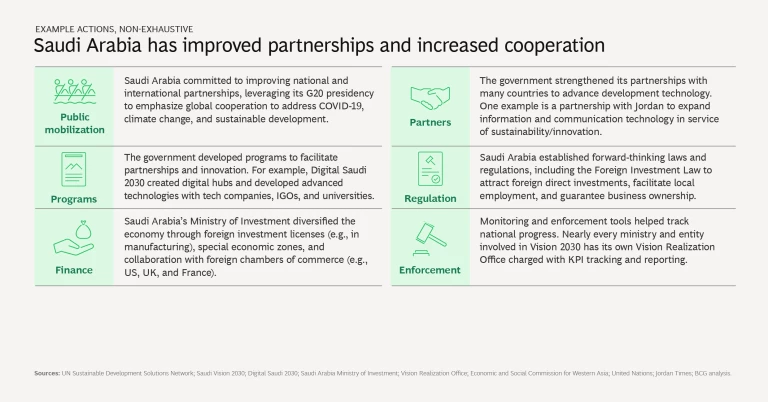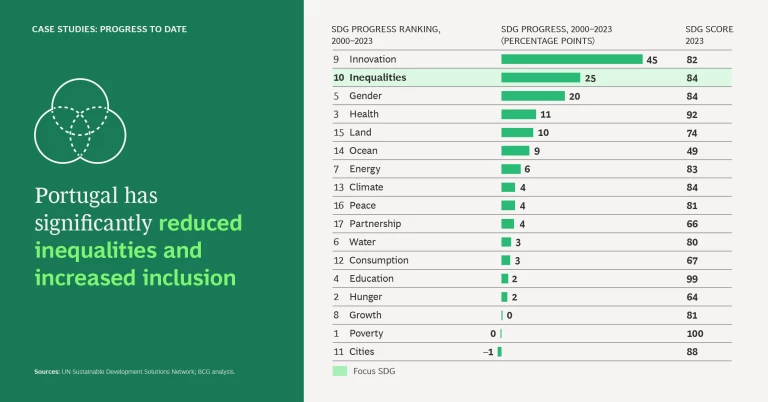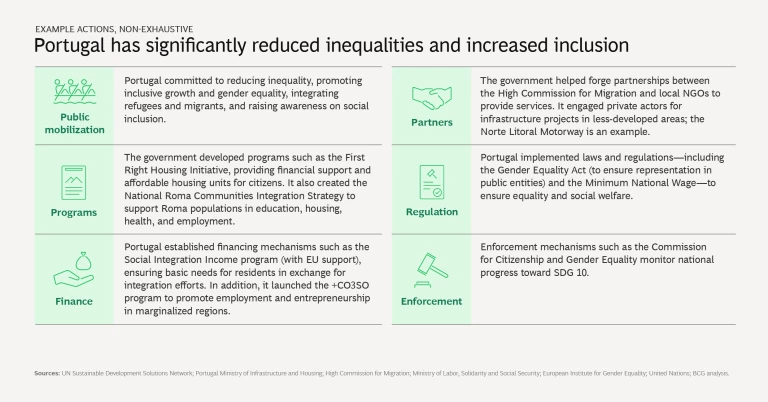At the United Nations Sustainable Development Goals (SDG) Summit in New York on September 18, 2023, a sense of urgency accompanied the deliberations. Back in 2015, the UN had unanimously adopted 17 global goals, with a 15-year deadline for reaching them, as part of its 2030 Agenda for Sustainable Development. Now, half the time had elapsed, and progress was so slow that the UN’s leadership declared, “the achievement of the goals is in peril.” Just 15% of the goals are on track, while 48% are moderately to severely off track, and 37% are either making no progress at all or regressing.
Yet the meeting also recognized that it is not too late to finish the job. Each of the 17 SDGs has targets associated with it, and enough targets have already been met to prove the value of government action. SDG-related initiatives have brought electric power to more than 800 million people; mortality rates for children under age 5 have decreased significantly in 146 countries; and the annual number of AIDS-related deaths globally has fallen by one-half.
Each year, the UN Sustainable Development Solutions Network assesses the progress that each country and the world at large have made toward the SDGs, based on economic and social data. The resulting Sustainable Development Report quantifies, on a scale of 0 to 100, where each country currently stands in its progress toward achieving each SDG. This year, the report shows some progress but also indicates that a great deal more remains to be done, with most of the SDGs in need of accelerated action. (See Exhibit 1.)
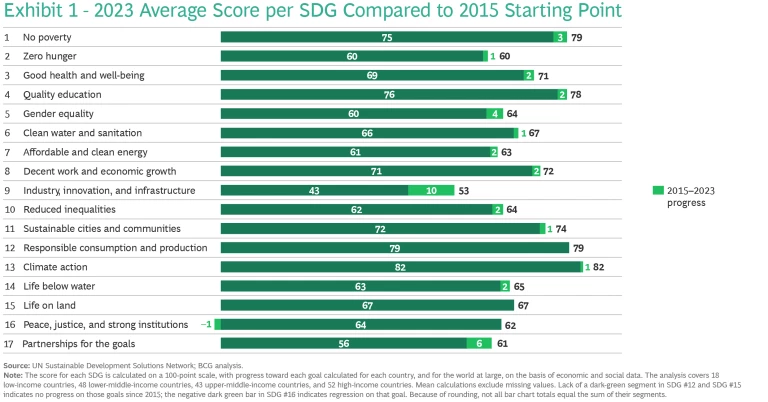
The September meeting provided clear evidence of continued political will to sustain the effort. Most government leaders and global business decision makers understand what needs to happen and why. But they are still not making the goals a priority. We need to look at how—how governments can act decisively and effectively, how stakeholders can mobilize their activity, and how all participants can extend the political longevity of SDG efforts. The purpose of this article is to articulate the urgency of SDG action and show that solutions are possible.
Building on Success
At the summit, many speakers discussed global events that have slowed progress since 2015. Crises such as the COVID-19 pandemic and extreme weather events associated with climate change have diverted resources. The invasion of Ukraine, increased political polarization worldwide, and the rise in debt have made global collaboration and collective action more difficult. National governments are preoccupied with local, short-term political agendas, while the SDGs represent long-term, global initiatives. Efforts to achieve them typically require sustained action across more than a single election cycle.
To improve the trajectory of current efforts, we must first recognize the power of government action that has already occurred. Although the problems that the SDGs address may seem intractable, efforts undertaken at the national and local levels have achieved significant success in ameliorating them.
Notably, the most profound progress on SDGs is not happening in geographies that possess the greatest economic wealth. When we analyzed SDG report data by the World Bank’s designated national income levels to understand progress from 2015 to 2023, we found that lower-middle-income countries (LMICs) had the greatest overall track record of progress toward the goals (about 2.7 percentage points across all SDGs), followed closely by low-income countries (LICs) at 2.4 percentage points, and then by upper-middle-income countries (UMICs), at about 2 percentage points. High-income countries (HICs) increased their scores the least, by 1.9 percentage points, in large part because they had higher starting positions. In each of the four national income categories, individual countries made very impressive progress toward the goals. The top-progressing countries in each income category—Rwanda among LICS, Côte d’Ivoire among LMICs, Indonesia among UMICs, and Saudi Arabia among HICs—improved their overall SDG scores by 5 to 8 percentage points.
Exhibit 2 details the progress that each national income group has made in the past eight years. The results in clusters A and B deserve special attention. Despite their low overall SDG scores, LICs and LMICs are making rapid improvements toward several SDGs, including health and education. In general, the greatest progress occurred in the innovation SDG, especially among LMICs (cluster C). This is significant because a high level of innovation, particularly in digitization, can enable progress toward the other SDGs.
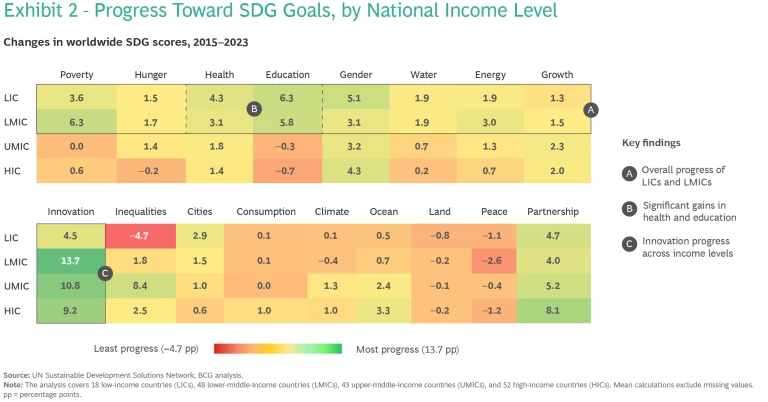
Since 2015, nations in the top quartile of LMICs by progress made—a group that includes, among others, Senegal, Benin, Bhutan, Cambodia, Bangladesh, and India—have increased their average SDG score by 3.9 percentage points, almost twice the global average of 2.2 points. This group also outperformed the top quartile of countries in other income brackets.
The top 25% of LMICs by progress made have achieved significant advances in SDGs with potential to positively impact their people: industry, innovation, and infrastructure (about two times the average progress); poverty reduction (about 3x); health (2x); and education (4x). In terms of the long-term impact of government action in priority areas, some LMICs have made staggering progress on specific SDGs since 2000: poverty reduction by 44 percentage points in Uzbekistan; education by 70 points in Bhutan. We also see the beginnings of powerful forward-looking government action—for example, a focus on climate change mitigation in Lagos, Nigeria. (See the sidebar “Impact Acceleration for Climate Change.”)
Impact Acceleration for Climate Change
The United Nations Environmental Programme (UNEP) estimates that emerging economies will need from $140 billion to $300 billion by 2030, on top of their existing climate mitigation budgets, to handle the risks and effects of climate change. Private sector funding is limited, in part because business investors don’t yet grasp the risks they face from climate change—or the financial opportunities. Similarly, it is hard to make a funding case in the public sector, given the many demands on governments and the challenges involved in articulating return on investment.
National adaptation plans (NAPs) and national adaptation and resilience plans, originally developed by UNEP, offer a format for organizing A&R initiatives around the world. There is no universal blueprint because each locale is different, and A&R solutions require significant local technical knowledge and input. As a group, however, well-developed NAPs provide a good example of what we call the “impact acceleration framework” in action.
Governments can mobilize the public with commitments toward A&R, including practical guidance on how to respond to a flood, fire, or drought if it occurs. They can design NAPs and other mitigation programs—for instance, to create disaster-resistant housing projects or to set up resilient transportation routes.
Governments can also engage with climate funds and private sector partners in advance to fund specific initiatives such as decentralized energy systems that are less vulnerable to crises. They can introduce regulations with incentives for climate-friendly building (for example, water conservation requirements) and establish minimum levels of reporting and disclosure for climate impact, integrating enforcement with types of other housing and infrastructure enforcement.
Germany and the greater Lagos region in Nigeria offer two models of A&R. The German Adaptation Strategy builds on an institutional commitment by the country’s government to define national A&R priorities and related programs. For example, Germany’s urban climate initiatives aim to mitigate the effects of heat and rainstorms, deploying green roofs, energy-efficient materials, and other building construction innovations. Germany also publicly committed to co-finance large A&R initiatives with private partners. One example is the InsuResilience Solutions Fund, which provides financial and insurance solutions for climate and disaster risks.
These programs receive crucial support from relevant regulations—such as construction standards mandating the ability to withstand extreme weather events—and enforcement mechanisms. The Ministry for the Environment produces regular monitoring reports and provides tools to track progress on implementation.
Germany also partners with other countries to develop their A&R strategies, in part through financial support. For example, the country’s Ministry for Economic Cooperation and Development supported Central Asian nations in establishing sustainable regional water management through the Transboundary Water Management advisory group. In a similar vein, Germany’s Agency for International Cooperation provides a wide range of technical assistance and capacity-building programs in low-income countries and low-middle-income countries, including financial services for small-scale farmers in Côte d’Ivoire, Nigeria, and other African countries.
Another example of an A&R strategy is Nigeria’s Lagos Climate Adaptation and Resilience Plan (LCARP), a large-scale effort that proposes multiple solutions to adaptation and resilience needs. The government of Lagos State, which launched the plan in 2022, elevated A&R to the forefront of its policy planning. As government leaders engaged with the private sector during the drafting process, they realized that they could coordinate financing more effectively if they created a robust roadmap and packaged the projects to be funding ready. Adopting this approach also enabled their investment partners to focus on programs that aligned with their priorities. Since the plan launched, Lagos State has continued to engage with potential funders, developing a bankable project pipeline to unlock private financing for A&R.
Some LCARP programs emphasize monitoring and assessment, continuously tracking real-time threats of flooding, sea level rise, and extreme heat. Others bolster key infrastructure by building climate-resilient facilities, stormwater drainage networks, and sea walls.
Many LCARP programs involve capital investment in energy, transportation, waste management, water, and agricultural systems. Examples include a resilient, low-emission public transportation network; rehabilitation of landfills and construction of a waste-to-energy plant; and an initiative to plant mangroves along the coast to hold back flooding, with potential links to carbon credits.
The plan also integrates climate risks into decision making, regulations, and policies in areas such as urban planning and land use, building standards, and enforcement of regulations on harmful practices.
Progress stories such as these suggest that governments in any part of the world and at any income level can make substantial headway on their priority SDGs. Given their progress, we can assert that they don’t need fancy solutions or novel tools. They can mobilize the people and tools already available.
Accelerated Catalytic Impact
The SDGs can be catalytic for countries. A few initiatives tagged to specific national priorities can unlock new resources, make the most of existing resources, and unleash a collective public will to make things happen. Achieving early success builds trust, attracts additional support, and accelerates further progress.
When implemented at a national level, an effective impact acceleration approach has several key qualities:
- It aligns with national priorities. Governments focus on SDGs that resonate with influential decision-makers and with the general public, which translates into political enthusiasm.
- It is comprehensive and clear. People understand why the government is moving in a particular direction and how their own efforts fit into the scheme. They are motivated to participate in the endeavor.
- It is organized through high-visibility, long-term programs that include visionary targets and practical milestones for tracking progress along the way.
- It produces rapid results and longer-term benefits, reinforcing the SDG initiatives' relevance and political viability.
- It is designed to attract private and public funding, backed by a national investment plan that dedicates local resources to the effort.
- It has political longevity, helping to build the credibility needed for ambitious, longer-term planning and action.
- It is innovative, taking advantage of technological advances such as generative AI (GenAI) and using existing tools and methods in next-generation ways.
- It engages partners in the private sector, including tech and financial companies, to participate with and support government efforts. This can increase the country’s economic value proposition to the world, its revenue sources, and its overall capacity to deliver results. In effect, these partnerships galvanize the private sector to help deliver public sector value.
- It entails a public commitment, with specified budgets and human resources, to address priority SDGs.
- It calls for continuing investment in the core capabilities of government, including workforce capacity, digital technology, and relevant skills.
The challenge is to bring all these elements together in a way that achieves results. That doesn’t happen simply by assembling task forces and putting people in charge. Rather it involves accelerating planned changes over time to reinforce progress, make the most of a country’s resources, however limited, and invite dedicated commitment from a wide group of participants.
Think Big, Start Small, Scale Fast
The public sector has the most essential role to play in course-correcting the SDG trajectory. As the 2030 Agenda points out, governments “have the primary responsibility for implementing SDGs.” Their overarching authority gives them the means to craft programs, recruit partners, and establish cross-organizational mechanisms.
Nonetheless, most governments lack a methodology for sustainable transformation. The right way to organize multiple moves so that they reinforce one another and pick up speed isn’t obvious. We have found, however, that the most effective framework for impact acceleration is a simple sequence of three stages:
- Think big. Choose priorities that matter to your country and its people. Develop a clear, aspirational vision of what you hope to achieve and how it will change lives. If the goal is affordable and clean energy (SDG 7), express in words and images what it might mean: children studying by electric light after the sun goes down; carpenters using machine tools; people finding refuge in air-conditioned sanctuaries during heat waves; and long-distance jobs made possible by reliable internet infrastructure. Engage in conversations that invite people to imagine what they would do with more reliable electricity and without the threat of frequent blackouts, and incorporate their best ideas into the story line.
- Start small. Pick your battles carefully, focusing on areas of urgent, evident need, where specific goals and deliverables are within reach. Develop a few initial projects to demonstrate positive results—perhaps in local areas, perhaps with a sharp focus. If sustainable cities and communities (SDG 11) are a high-priority goal, you might start by establishing an electric-vehicle-based mass transit service that connects a few major suburbs with employment centers. These initial projects will meet real needs rapidly, and what you learn from them may influence the design of future transit systems.
- Scale fast. Gather resources—including financing, private sector partnerships, outside support, and regulations, with a focus on local multistakeholder collaboration—to expand SDG initiatives to the entire country and endow them with political longevity. A coastal nation focusing on the goal of improving life below water (SDG 14), for example, might take a leading role in international regulatory efforts, such as the UN’s recently adopted High Seas Treaty for protecting marine biodiversity, or the World Trade Organization’s agreement on fisheries subsidies, which aims to prevent overfishing. Fishing fleets may cooperate in endeavors of this sort, knowing that their goal is to replenish fish stocks. “All-of-society” participation is necessary to ensure inclusive and powerful scaling.
The private sector plays a critical role in gaining scale. The effort expands much more rapidly when companies take on the challenge and view themselves as socially transformative businesses. This can happen more readily if governments create an enabling environment for business and consider alternative ways of implementing programs. In some cases, the private sector can be an optimal delivery partner, improving the provision of government services through increased efficiency, accountability, and oversight.
The strategic sequencing of impact acceleration activity generates a virtuous cycle—a self-reinforcing system that continually extends its own political longevity. Governments think big by developing ambitious plans. They start small to make measurable progress in areas such as poverty alleviation (SDG 1), health care (SDG 3), and education (SDG 4). Successful short-term results attract funders, private sector partners, and supportive citizens, inspiring public trust in the current political system. The governments then accelerate the effort by carefully timing the financing and operations to scale fast, building the political longevity necessary to realize ambitious, long-term plans.
At the same time, with each new round of successful results, governments learn. They become more efficient and effective in designing programs, developing financing strategies, maintaining trusting and productive partnerships, and reimagining how they operate. They strengthen their regulatory and enforcement frameworks and apply new capabilities and partnerships to greater aspirations in the next round. Even seemingly insurmountable problems, such as developing the resilience needed to face the extreme weather effects of climate change (SDG 13), can be addressed in this way.
An Agenda Based on Leverage
Governments are recognized for what they can do, and the path for SDGs is no exception. Governments can use six major drivers as they follow the virtuous cycle of the impact acceleration approach. (See Exhibit 3.)
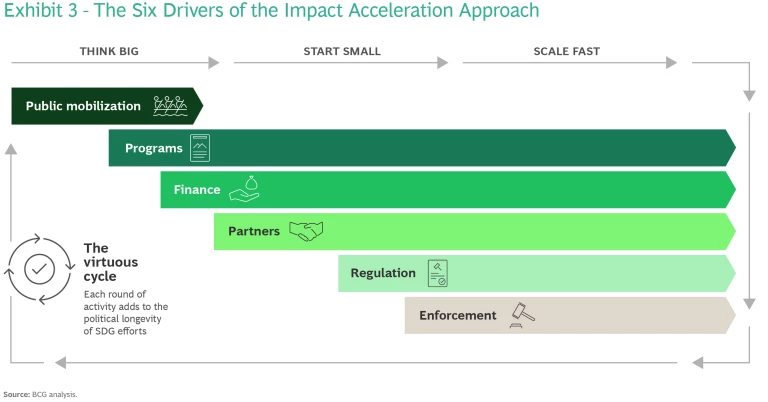
Public Mobilization
Gaining genuine public buy-in is an essential first step. Think of active citizen participation as a resource to harness. Although it requires some attention to enlist properly, it accelerates the pace of action once engaged.
Develop an SDG strategy and agenda, mapping top national priorities to the SDGs. Craft a clear public narrative rooted in listening and responding to voices in the country, and openly commit resources to particular sustainable development objectives, chosen for your country, tied to an ambitious but achievable time frame.
In interactions with constituents, don’t impose your vision on them. Rather, listen with the goal of gaining insights into substantive needs and concerns. In school and community meeting rooms, conduct dialogues, open to the public, about why the goal matters. If enough people have internet access, consider conducting similar conversations online.
Drawing on what you hear, make an explicit commitment to devote resources and attention to the desired outcome, and explain the sequence of milestones you expect to reach.
Programs
Design transformative, high-visibility programs that address high-priority challenges over a long time period such as ten years. These programs should include robust monitoring and evaluation systems, grounded in measurable outcomes and key responsibility areas. For example, a program to address quality education (SDG 4) might name the number of schools that you plan to open and support, and the ways in which you intend to assess student achievement.
Programs are the core element of this approach. They provide a context for securing financing and partnerships. As you design programs to launch, consider how rapidly they can scale and how profoundly they may alter the way people think and work. Finally, establish a team or group responsible for oversight, and create incentives for them to achieve results.
Finance
Ambitious programs typically require intensive funding. During the “think big” phase, create a broad, comprehensive financing strategy to support impact acceleration. Put every possible source of income—including taxation, debt refinancing, and access to reserves—on the table. Don’t defer the task of finding additional sources of funding until later, because it may be difficult to follow through.
In emerging economies, look for innovative private-sector opportunities that are specifically designed for LICs and LMICs, such as blended finance (combining public and private investment), multilateral development bank funding, and philanthropic development. Strengthen your working relationships with trustworthy funding sources. Invite them into discussions to help you evaluate and refine ideas. (See the sidebar “Strategies for Innovative Financing.”)
Strategies for Innovative Financing
Innovative financing is a crucial aspect of managing the barriers to raising capital that exist in emerging economies. Most funders perceive low-income countries (LICs) and low-middle-income countries (LMICs) as high-risk partners. As a result, many projects that need financing depend on the limited capital available from multilateral development banks (MDBs) or bilateral aid. Because LIC and LMIC governments must rely on financial initiatives from the Overseas Development Institute or from development finance institutions (DFIs), they lose opportunities to create wealth through SDG-related investment.
Many countries also struggle with unsustainable levels of public debt, often held in US currency or with other strings attached. This burden makes it even more difficult for governments to take a leading role in financing the projects they need. Finally, many governments and private sector investors must overcome a history of mutual mistrust, as each side worries that the other will fail to follow through or will take unfair advantage of whatever deal they negotiate.
To meet these challenges, new innovative financing solutions that source diverse and blended (public-private-MDB) capital for SDG initiatives are emerging. Adopting an innovative financing strategy entails refreshing conventional approaches to public sector funding and rethinking the status quo of development finance. Fortunately, there are ways to creatively manage the risks inherent in funding social, developmental and infrastructural programs.
To scale innovative funding and make progress on SDGs, governments can use the six drivers of the impact acceleration approach:
- Public Mobilization. Motivate and mobilize the public by announcing a commitment to increase FDI and other external investments. Set a numerical goal for this vision: “We will mobilize $X in the next ten years to address our SDG priorities.” Explain the steps that the government is taking and its reasons for taking them.
- Programs. Stand up agencies, funds, and projects to facilitate, pool, and regulate the flow of funds to high-impact projects. These may include innovative financial instruments such as outcome-based social impact bonds, but they should be transparent and easy to explain, so people trust that they will deliver.
- Finance. Coordinate innovative finance efforts with more conventional funding sources to ensure that the spending goes toward the SDGs and is not diverted to other uses.
- Partners. Governments can use national adaptation plans (NAPs) to engage climate funds, DFIs, and banks to fund specific initiatives such as investing in decentralized energy systems to reduce natural disaster vulnerabilities or in local resilient transportation infrastructure. Over time, these can expand into larger-scale projects such as coastal protection infrastructure or housing for displaced people.
- Regulation. Governments can use NAPs to integrate regulations that incentivize SDG-friendly development—such as requirements for water-saving fixtures—or strengthen disclosure requirements.
- Enforcement. Governments can support publicly accessible reporting and auditing mechanisms for the innovative financing measures that they put in place.
The UK has a strong track record in developing and deploying innovative financing mechanisms, both at home and in developing countries. Its large-scale programs mobilize multiple partners and co-funding mechanisms. For example, the Natural Disaster Fund, developed by the UK and Germany, couples government funding with reinsurance capital to support poor populations that are vulnerable to extreme weather in LICs and LMICs. The UK has also developed domestic financing mechanisms such as social impact bonds (SIBs). The Manchester SIB for Homelessness leverages private investment and nonprofit program management, with the government committing to repay a program’s costs when the initiative meets targets for homelessness reduction.
The UK’s strong legal framework also supports innovative financial regulations such as regulatory sandboxes and innovation hubs that encourage experimentation with rules. Enforcement mechanisms for all funding programs include robust monitoring and evaluation tools backed by extensive data collection and reporting.
Another country that has developed several innovative financing programs is Brazil. One such program is Green Bonds, which finances renewable energy projects, sustainable transportation, and green agriculture and forestry initiatives. The Brazilian Development Bank (BNDES) operates one Green Bond itself but also mobilizes capital more broadly, drawing in commercial banks and nonprofits to fund high-impact programs. The BNDES Agribusiness Fund promotes sustainable agriculture and food security in rural areas.
The Brazilian government also teamed with multiple partners and co-funders—including developed country funds from Norway and Germany, private investors, and philanthropies—to launch the Amazon Fund. This fund uses performance-based financing, along with regulations and enforcements designed with transparency in mind, to promote sustainable development and strengthen the capacity of the local population to manage natural resources.
In addition, Brazil’s extensive ABC+ Plan promotes sustainable agriculture by encouraging such techniques as no-till farming and restoration of degraded pasture lands. The country has also recently updated Plano Safra, its annual loan financing plan for the agriculture and livestock industries, to increase its emphasis on sustainability. Plano Safra now offers tiered interest rates on credit lines to farmers who adopt sustainable practices.
It's important to allocate investments to the most catalytic transformational programs, and away from “sacred cow” projects that may no longer be useful or cost effective. During the “start small” phase, help funders provide seed capital for early-stage ventures that are still developing their proof of concept. As you move into the “scale fast” phase, continue to develop your financing expertise. Learn how to attract high-impact, market-maker private investments by helping private investors manage risk.
Partners
Governments cannot achieve the SDG goals on their own. They need to build and mobilize a robust multistakeholder ecosystem, with incentives for businesses to engage with government and civil society. In addition to the private sector, partnerships should include nonprofits, community groups, and global entities such as multilateral development banks (MDBs), bilateral funders, and international philanthropies. Governments should also work with other governments through regional blocs or multilateral agreements, collaborating on SDG projects and holding one another accountable.
You can use the partnership driver when thinking big to set precedents for collaborative design. Program leaders engage with partners throughout the process of starting small and scaling fast. Governments can engage partners to support initial projects, and then use those same networks of companies and organizations to foster a broader range of activity.
Work with partners when you need them most. For example, draw on the social sector (nonprofits) to help design, fund, and implement proof-of-concept initial efforts. Deploy private-sector distribution channels when you scale up your most effective programs. The bolder the initiative, the more valuable partnerships can be. For example, in LICs, local and national banks and MDBs can help establish a level of legitimacy that convinces others to join.
Regulation
Establish social and environmental regulations that encourage businesses to pursue SDG-inclusive policies. These might include incentives to adopt inclusive hiring practices and reduce inequality (SDG 10) or to make more efficient use of water and energy (SDGs 6 and 7). In the “start small” phase, you can reward innovation by creating “regulatory sandboxes” that permit businesses engaged in potentially high-impact research to develop and test trial products and approaches to providing services. Organize regulatory process so that new rules incorporate lessons from real-world startups and sandboxed processes, and design incentives accordingly.
Create an overall regulatory environment that rewards socially transformative businesses and enables them to gain revenue and reduce costs when their offerings are relevant to SDG goals. Examples include the EU’s carbon tax regime (SDG 13) and its due diligence rules for supply chain human rights (SDG 10). Regulations like these often start in one European country and then scale across the EU proving their effectiveness.
Enforcement
In LICs, LMICs, and some parts of higher-income countries, people may have had bad experiences with law enforcement and other public institutions. The SDGs offer governments a way to establish or strengthen public trust. To encourage compliance with related regulations, use existing state enforcement resources. Focus on raising transparency. For example, set up new programs that are easy for the public to assess and understand. Work to reduce corruption, and set up robust mechanisms to deter bureaucratic misconduct. Use the impact acceleration approach to introduce formal economic mechanisms (such as digital payment systems) that discourage reliance on the informal shadow economy.
Workforce and Digital: The Underlying Enablers
Public sector efficiency and effectiveness are critically important to making progress toward SDGs. In many countries, this entails dramatically improving the efficiency of government processes. The UN’s own SDG-oriented initiatives, such as its Future of Government initiative, make public sector transformation a priority. This should take place through well-managed investment in two areas: workforce capacity and digital enablement.
Workforce capacity comprises people and processes. Public sector officials and staff need training in next-generation skills, along with opportunities for career advancement that recognize their contribution to realizing SDGs. Governments can build their workforce capabilities further by strategically recruiting talent, offering positions to qualified current residents or immigrants. They can streamline bureaucratic bottlenecks, introduce agile processes in areas of especially high impact, and cultivate interdepartmental and intergovernmental learning opportunities around the most important initiatives and SDGs.
Public servants who successfully foster development progress tend to have distinctive energy, attitudes, and skills. One key attribute may be their ability to leverage trust—to gain the confidence of financiers, developers, and business leaders. They also work well in partnerships. They gravitate toward tangible results, especially those with broad positive human impact. They recognize the need to reduce inequity and help underserved populations. They are institutional leaders who understand the value of cohesive teams, as well as the importance of organizational learning and flexibility. Crucially, they are willing to renew processes and invest in human capital, and to combat corruption and enforce regulations and policies fairly and sustainably.
Although these qualities are easy to describe, they can be difficult to bring to reality. But when agency leaders welcome this type of attitude, establish robust performance management systems, and reward high-potential individuals, the atmosphere of the workplace changes. People feel more inclined to commit themselves to longer-term government efforts and feel that they are part of something greater than themselves.
The other powerful accelerant is digital enablement. Data shows that countries with advanced digital infrastructure and affordability outperform otherwise comparable countries by 40% or more on overall SDG progress. The most effective digital investments include foundational infrastructure (also known as “digital public infrastructure”), expanded connectivity, and digitized delivery of government services. Governments can also invest in data systems, analytics, and GenAI tools, instilling a culture of continuous learning that helps people in monitoring, evaluating, and accelerating SDG progress.
A digital design strategy, particularly at the “scale fast” stage, can link priority SDGs to evolving governmental digital systems and thus scale proven solutions in an interoperable way. In fact, digital has been identified as a key accelerant for 70% of SDG targets, and we believe digital solutions exist for all SDGs. For example, governments can progress toward reduced inequalities (SDG 10) by redesigning public and social services systems with a digital-first lens and ensuring that people have access to the internet and to the interfaces necessary to use those systems.
Defining the Path Forward
Governments face a number of choices as they initiate their own path, and they should select their priorities carefully—identifying the SDGs with the highest potential impact, based on their goals, national priorities, and geographical context.
After aligning the SDGs with their national agendas, governments should develop a plan for public mobilization, bringing on board stakeholders whose commitment will improve your prospects for success. They should develop a long-term program design with specified steps and milestones along the way to guide their country from thinking big to starting small to scaling fast. And they should incorporate the resources already at their disposal. Most governments already have many of the tools they need at hand; they just have to start using them more effectively.
Exhibit 4 illustrates how such a plan might vary from one country to another, depending on the country’s national income level and its institutional capacity for transformative change. Emerging economies may need to build stronger institutions, for example, while mature economies may be able to focus on improving conditions for the underserved in their own countries—an important aspect of the SDGs—and on establishing partnerships with other countries and contributing to multilateral efforts.
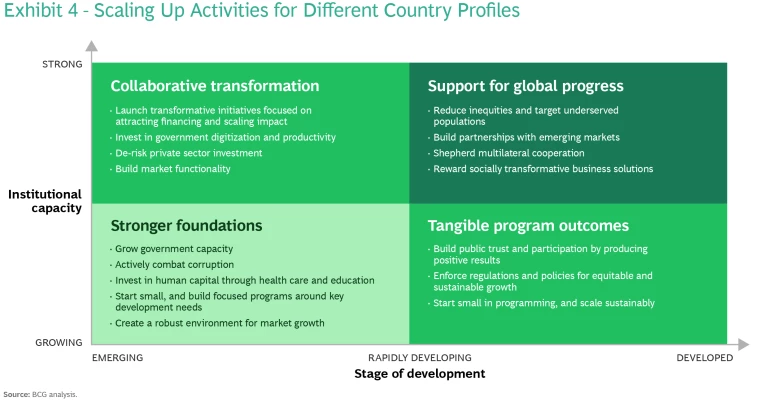
When the UN introduced the SDG goals in 2015, they represented a shared vision of how the world’s nations might come together to solve some of their most significant common problems. Since then, we have learned that to make progress, we must operate at a local level, with each nation pursuing its own priorities. Even so, the overarching need remains a shared one. Our ability to act independently and collectively makes humanity stronger.
Given the breadth of knowledge needed to compile this comprehensive report, the authors would like to acknowledge and thank the BCG experts and public sector professionals who generously shared their expertise: Bart de Langhe, Malika Dia, Qahir Dhanani, Elizabeth Eze, Faisal Faraz, Abhishek Gopalka, Joerg Hildebrandt, Leila Hoteit, Isabel Matthes, Mark Ndoli, Takeshi Okamoto, Peter Ong, Tolu Oyekan, Simone Parravicini, Leonor Saitkoulov, Dave Sivaprasad, Hamza Tber, Zoe Karl Waithaka, Wendy Woods, Annika Zawadzki, Charlotte Zhai, Yvonne Zhou, Brooke Bollyky, Seema Bansal, and many others.
Their contributions have played an instrumental role in shaping the content and depth of this report and their guidance has been invaluable in enriching our understanding of public sector needs and capabilities.





